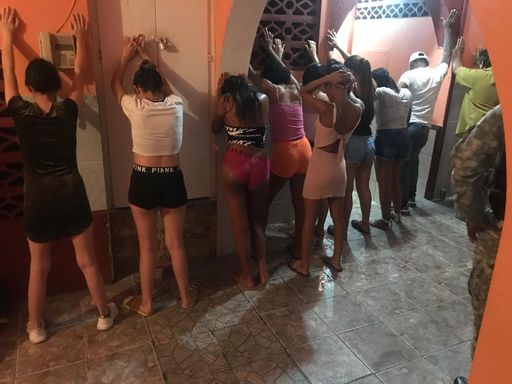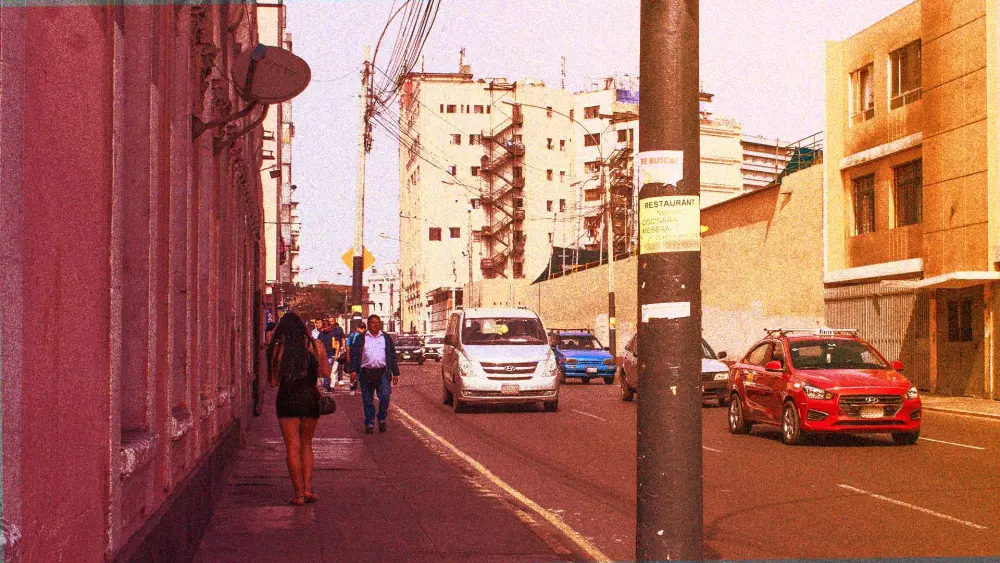
The sex trade has long been part of the fabric of Peru, but the rapid expansion of one of the region’s most ruthless gangs has seen a surge in violence against sex workers
Simeon Tegel
LIMA
The sex trade has long been part of the fabric of Peru, but the rapid expansion of one of the region’s most ruthless gangs has seen a surge in violence against sex workers as the group has exploited Venezuela’s migrant crisis to build a trafficking empire.
Tren de Aragua’s activities include kidnapping, drug smuggling, armed robbery, extortion, and human trafficking. Local branches in Peru have been seeking to push out competitors in the sex industry, replacing them with groups they control.
“There have been successive waves of migration in the Peruvian prostitution industry. First it was Ecuadorians, then Colombians, and now Venezuelans,” said Angela Villón, the head of Miluska, a collective of sex workers in the Peruvian capital, Lima.
“The Venezuelans come with no respect for life,” she told The New Humanitarian. “Before, they might use a blade to cut off your hair or slash your clothes, but they wouldn’t kill you. That’s all changed now. The Venezuelans kill. They kill the women, but they also kill their bosses.”
According to unofficial figures compiled by Villón, 70 of her co-workers were either murdered or disappeared in 2022. In the first four months of 2023, 18 more vanished, she said. According to UNAIDS, more than 10 sex workers were killed across Peru in the first six weeks of this year alone. The National Police of Peru (PNP) did not respond to The New Humanitarian’s requests for comments.
Emerging out of a local labor union working on a railway construction project in Venezuela’s Aragua state, Tren de Aragua’s ascent has to a large extent been built on the exploitation of Venezuelan women since the country’s economic implosion.
Led from its prison headquarters – complete with a gym, a swimming pool, a playground, a restaurant, and a nightclub – by Héctor Rusthenford Guerrero Flores, alias “Niño Guerrero”, it has rapidly expanded since 2018 along the routes taken by Venezuelan migrants. It now operates in Venezuela, Chile, Ecuador, Colombia, Peru, Bolivia, Brazil, and Panama.
First, the group extended its operations by scouring beauty pageants for vulnerable girls to seduce into becoming jail escorts. Then, after taking control of the smuggling routes for migrants escaping Venezuela’s downfall, it expanded regionally by forcing vulnerable women into the sex trade by extortion or threatening their family members back home.
The surge in violence has driven the sex trade further underground in Peru, just as social conservatives opposed to even using the word “gender” in policy documents have gained control of the country’s Congress and several other public institutions, including the government-run human rights watchdog (Defensoría del Pueblo). This, women’s rights advocates say, is making it even harder to support victims of sex trafficking, let alone provide them with safe routes out of lives of exploitation.
“This issue is not allowed to be public,” Villón said. “That puts sex workers in an even greater position of vulnerability.”
‘They even know where their children are’
Even in Latin America, Peru’s economy stands out for its informal sector, which employs between 70% and 80% of the working population. Of the many criminal activities, human trafficking is one of the most lucrative, generating profits of at least $1.3 billion a year, $700 million of which is based on sexual exploitation. Tren de Aragua reportedly makes around $275,000 a month from 10 sex worker rings in Lima alone.
According to the UN’s Global Report on Trafficking in Persons 2022, up to 87% of reported victims of sexual exploitation in the region are women, and 11% are girls. They are also the target of physical violence from traffickers at a rate three times higher than men, the report says: 9% are victims of “extreme” violence, 44% of physical violence, and 26% of threats and psychological violence.
“When they arrive, the victims realize that they are not getting what they were offered,” said Vanessa Soto, who works for the local nonprofit Promsex with victims of trafficking in the jungle region of Madre de Dios, where sex traffickers are mainly Peruvian.
“The gangs have them completely under their thumbs. They even know where their children are back in Venezuela.”
“The trafficker will pose as a friend or ally of the victim. [He]’ll be sympathetic and talk about how they can together get out of this hole,” she said. “The women are charged for absolutely everything, starting with their transport from home, their room, their clothes and many other things. Basically, they are told that they have a debt. They can earn money for every beer that a client consumes, but they will soon realize that their best way to earn money is sex.”
Peru hosts the second highest number of Venezuelan migrants after Colombia: 1.5 million of the 7.1 million globally. Victims of sex trafficking in Peru include a disproportionately high number of Venezuelan migrants: In 2022, the PNP rescued 947 victims of human trafficking; 887 of them were women and 435 were Venezuelan.
“[Venezuelan refugees] are especially vulnerable,” said Karina Jensen, a human trafficking specialist with the International Labor Organization (ILO) in Lima. “They have no documents, are in Peru irregularly, and have no family or social network that can support them.
“At one point, [Tren de Aragua] were bringing dozens of women a day into the country, and they didn’t have anywhere for them to go. So, they started trying to move the Peruvian women out and charging them [fees to work in the streets they control].”
Diana Mabel, a sex worker gunned down by two killers on a motorcycle in downtown Lima late last year, is believed to have been one victim of that trend, after she repeatedly refused to pay the criminals trying to extort her.
The militarization of Peru’s borders has only pushed more migrants into the hands of traffickers. Venezuelan women come to Peru hoping to find a better life, as rampant inflation, insecurity, food shortages, and the breakdown of the healthcare system plague their country.

“But [the gangs] have them completely under their thumbs. They even know where their children are back in Venezuela,” Villón said. “They started kidnapping women. They put a revolver to [their] heads. They download the contacts from [their] phones and send them threatening messages.”
These women face a life of hardship. They drop out of school and lose contact with families — in some cases cut off from their own children. They suffer health issues, ranging from sexually transmitted diseases (STDs) to mental health problems. According to prosecutors, 4% of victims haven’t finished primary school, 11.2% haven’t started secondary school, and 16.9% haven’t finished secondary school.
What aid groups are doing to help?
Despite the efforts of some police officers, prosecutors, and judges, experts say the Peruvian state is failing to deliver on its commitments to tackle sex trafficking. And few victims who escape or are rescued receive the psychological care or support they need.
A new national strategy that aims to address some of these failures is being put in place for the next seven years with the help of the ILO.
Ricardo Valdés, a former deputy interior minister who now works with the nonprofit Capital Humano y Social (CHS), told The New Humanitarian that women who leave the sex trade can take up to five years to move on from the trauma and resume normal lives. While NGOs can support these women, they can’t replace Peruvian government agencies, according to Valdés. “The state is the only one that can generate sustainability,” he said.
“The data is not consistent, complete, or coherent. It is poor quality and relates to cases that are reported, not necessarily to the reality of what is going on. It makes it impossible to develop effective, targeted policies.”
Nevertheless, some NGOs are trying to fill gaps and help the Peruvian authorities: from Catholic Relief Services helping to prevent women from falling into the hands of traffickers, to Promsex’s work in Madre de Dios assisting victims to recover, to other efforts to improve the judiciary system and the capabilities of prosecutors to pursue such crimes.
Veeduria Mirada Ciudadana, a group founded with CHS, empowers citizens to monitor the authorities’ progress in tackling the problem, while the UN’s migration agency, IOM, is training border agents to identify trafficking victims and offer gender-focused healthcare.
Julio Rodríguez, a human trafficking specialist at the Lima office of the ILO, warns that one of the first policy challenges is to accurately identify sex trafficking, including statistically.
“The data is not consistent, complete, or coherent,” Rodríguez said. “It is poor quality and relates to cases that are reported, not necessarily to the reality of what is going on. It makes it impossible to develop effective, targeted policies.”
Valdés said the problem is rooted in Peru’s weak institutions, and noted that it has worsened in the last two years of political instability under the chaotic administration of Pedro Castillo, whose failed coup attempt left his vice president, Dina Boluarte, in power. Her administration has been condemned both domestically and internationally for committing human rights abuses against anti-government protesters.
Official corruption and institutional incompetence means the traffickers know they’re unlikely to pay any penalty for their criminality. “Around four or six cases in 100 end in a conviction in Peru,” Valdés said. “There’s just too much impunity.”
Corruption, he added, compounds the issue, as gang members can simply pay off police officers to keep their operations going. “A business that has little risk and low costs is obviously going to work well,” Valdés said. “It’s sustainable.”
_________________
Simeon Tegel is a freelance journalist based in Peru, specializing in environmental issues and human rights
Courtesy: The New Humanitarian (Posted on Aug 8, 2023)